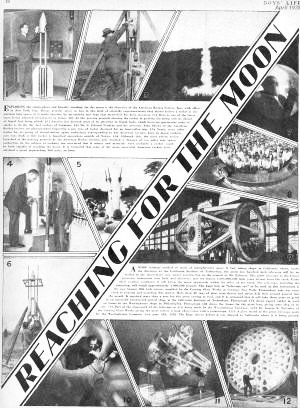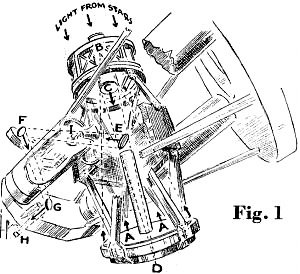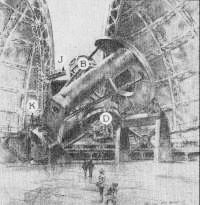 Table of Contents Table of Contents
The Boy Scouts of America has published Boys'
Life since January 1, 1911. I received it for a couple years in the late 1960s while in the
Scouts. I have begun buying copies on eBay to look for useful articles. As time permits, I will be glad
to scan articles for you. All copyrights (if any) are hereby acknowledged. Here are the
Boys' Life issues I have so far.
|
1938 was still two decades away
from when America would launch its first Earth-orbiting satellite (Explorer 1, 1958) and three
decades from when man would first walk on the moon (Apollo 11, 1969), yet work
was well underway by enthusiastic aerospace engineers, scientists, astronomers,
project managers, and others to accomplish those goals. While this Boys' Life
article boasts of rockets attaining speeds of 800 miles per hour, leaving Earth's
gravitational pull for a trip to the moon would require a
escape velocity of 25,000
miles per hour. Telescopes powerful enough to survey the moon's surface for determining
a safe location for landing were being readied with telescopes like constructed
200-inch Hale reflector,
having seen first light just nine years earlier. This type illustrated feature page
was common each month.
Reaching for the Moon
Exploring the stratosphere and literally reaching for the moon is the objective
of the American Rocket Society, Inc., with offices in New York City. Things actually
move so fast in this field of scientific experimentation that almost before a rocket
is dispatched into space, it is made obsolete by an entirely new type that meanwhile
has been invented (1) Here is one of the latest types being adjusted preparatory
to firing. (2) At the proving grounds showing the rocket in position for firing
with its charge of liquid fuel being added. (3) America has devoted most of its
attention to liquid fuels, which leave no spectacular wake of smoke as do the dry
fuel rockets of Germany. (4) Dr. G. Edward Pendray and his associate John Shesta
of the American Rocket Society are photographed inspecting a new type of rocket
destined for an interstellar trip. (5) Nearly every other nation has its group of
interplanetary space enthusiasts corresponding to our American Society; here in
Japan enthusiasm runs high as this rocket is launched somewhere outside of Tokyo.
(6) Although this, the most recent rocket launched at the proving grounds by the
American Rocket Society, only reached a distance of ten miles into space, authorities
on the subject of rocketry are convinced that if money and materials were available
a rocket could be capable of reaching the moon. It is estimated that some of the
more successful American rockets have attained a speed approaching 800 miles an
hour.
 A more intimate method of study of interplanetary
space is fast taking shape in California where, under the direction of the California
Institute of Technology, the giant two hundred inch telescope will be installed
in the observatory now under construction on the summit of Mt. Palomar. This giant
telescope is the largest precision instrument ever built and observers may see objects
1,000,000,000 light years distant from the earth. The telescope, including the mounting,
will weight approximately 1,000,000 pounds. The huge lens or "telescope eye" to
be used in this instrument is the now famous 200 inch mirror, moulded by the Corning
Glass Works at Corning, New York. Tremendous care was exercised in pouring and moulding
this mirror. More than 40 tons of glass were drawn and about half that amount poured
into the mould. It required more than a year for this great casting to cool, and
it is estimated that is will take three years to grind in an especially constructed
optical shop, at the California Institute of Technology. (7) shows expert welder
at work on frame in the Westinghouse shops in Philadelphia. (8) shows the frame
for the giant lens, giving some idea of its size. (9) Part of the framework of the
telescope as it is being made by the Westinghouse Company. (10) Dr. George V. McCauley
of the Corning Glass Works giving the great mirror a final observation with a polariscope.
(11) A glass model of the great telescope made by the Westinghouse Company
(12) The huge mirror before it was shipped to California where it is being ground. A more intimate method of study of interplanetary
space is fast taking shape in California where, under the direction of the California
Institute of Technology, the giant two hundred inch telescope will be installed
in the observatory now under construction on the summit of Mt. Palomar. This giant
telescope is the largest precision instrument ever built and observers may see objects
1,000,000,000 light years distant from the earth. The telescope, including the mounting,
will weight approximately 1,000,000 pounds. The huge lens or "telescope eye" to
be used in this instrument is the now famous 200 inch mirror, moulded by the Corning
Glass Works at Corning, New York. Tremendous care was exercised in pouring and moulding
this mirror. More than 40 tons of glass were drawn and about half that amount poured
into the mould. It required more than a year for this great casting to cool, and
it is estimated that is will take three years to grind in an especially constructed
optical shop, at the California Institute of Technology. (7) shows expert welder
at work on frame in the Westinghouse shops in Philadelphia. (8) shows the frame
for the giant lens, giving some idea of its size. (9) Part of the framework of the
telescope as it is being made by the Westinghouse Company. (10) Dr. George V. McCauley
of the Corning Glass Works giving the great mirror a final observation with a polariscope.
(11) A glass model of the great telescope made by the Westinghouse Company
(12) The huge mirror before it was shipped to California where it is being ground.
How the New 200 inch Telescope Works

We are all acquainted with the common telescope in which a series of lenses is
mounted in a long barrel, which can be shortened by sliding the segments together.
This is technically known as a refractory type.
In building a giant telescope it is impractical to make a barrel long enough
to accommodate the giant lenses. So a system of mirrors is combined with the lenses,
and we have what is known as a reflecting telescope. The 200 inch lens of the new
telescope described on page 18 is actually a mirror.
At right is reproduced an artist's conception of how it will look set up in the
observatory, above is a diagram explaining how it works.

The starlight having entered the open tube is reflected from the 200 inch mirror
AA back to a focal point at B. An observer can reach this point of first focus by
bridge J (Fig. 2). To send the rays to a second focal observation point D (Figs.
1 and 2) a convex mirror C intercepts the rays from A and B and reflects them down
to observation point D, where Fig. 2 shows a platform suspended underneath the 200
inch mirror. The rays arriving at D come through a tube fixed in the center of the
mirror. The rays may also be extended from mirror C to E, from E to F, from F to
G and from G to H (Fig. 1).
I is another point of focus, and down inside the huge arm (an open section of
which is shown) is a chamber for spectrographic work. These arms on each side of
the tube are parallel to the polar axis. The control board is located at K (Fig.
2). The great housing running at nearly right angles to the telescope is the counter
weight to the telescope. It permits the giant apparatus to be moved and aimed With
delicate control.
Posted December 18, 2021
(updated from original post on 5/5/2012)
|